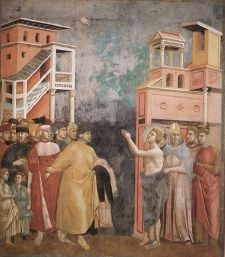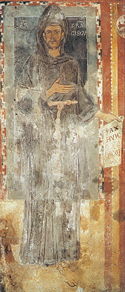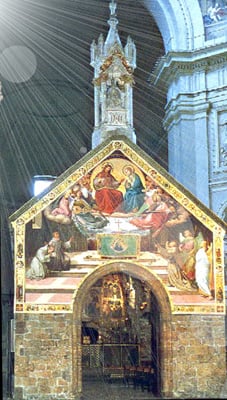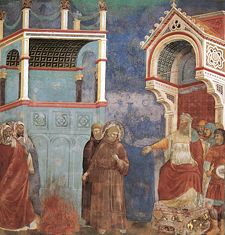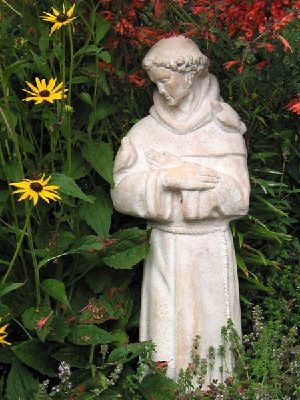| Saint Francis of Assisi | |
|---|---|
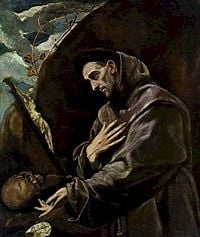
| |
| Confessor | |
| Born | 1182, Assisi, Italy |
| Died | October 4, 1226, Porziuncola, Assisi, Italy |
| Venerated in | Roman Catholicism and Anglicanism |
| Canonized (created a Saint) | July 16, 1228 |
| Major shrine | Basilica of St. Francis of Assisi |
| Calendar of saints: Feast Day | October 4 |
| Attributes | Dove, Stigmata |
| Patron saint | animals, merchants, Italy, Catholic Action, the environment, Cub Scouts |
Saint Francis of Assisi (1182 ‚Äď October 4, 1226) is for many people the most Christ-like Christian of all ages. For many, he is an iconic, inspirational figure whose life mirrors that of Jesus of Nazareth more closely than any other figure in Christian history. His love of nature, his renunciation of wealth, his simple lifestyle, his deep spirituality that resulted in the experience of the Stigmata (bodily marks or sensations of pain in locations corresponding to the crucifixion wounds of Jesus), his desire to spread the Gospel peacefully at a time when the Crusades identified the Church with violence, all mark him out as an exemplary figure.
Francis founded the Franciscan Order or "Friars Minor" (the first order), the Poor Clares (founded on his advice by his friend, Saint Clare) for women (the second order), and the Third Order for lay-people who remain in secular life. He is the patron saint of animals, merchants, Italy, Catholic action, and the natural environment.
Many of Saint Francis's ideas resonate with modern sensibilities. He is especially popular amongst peace and environmental activists. He respected nature and regarded all creatures as his brothers and sisters. He believed in the universal brotherhood of all people, women and men. He treated women equally with men, was aware of the feminine aspects of his own personality, and saw God as Mother and as Father. He realized the dangers of a church that was too worldly, and tried to reform it.
Saint Francis forbade members of the Third Order from bearing arms. He did not oppose war outright, but taught that nonviolence is the higher way. He visited the Holy Land and witnessed the Christian message to the Sultan of Egypt. Like Jesus, he attracted crowds when he preached and he spent a great deal of time with the poor and sick, especially lepers. His legacy lives on in the orders he founded, in songs and poetry. Most of all, he became a role model for Christians from that time forth who regarded imitation of Christ rather than devotion to Christ as the truest form of religion.
Although he was loyal to the Church, his sense of direct communion with God was so powerful that what he taught as God’s will was not always consistent with the teaching of the church. His charismatic and unpredictable leadership created a tension with the Church that was partly resolved by giving him control of an order which he headed outside the regular ranks of the priesthood. He continuously proclaimed himself to be imperfect, setting a standard of poverty that was so high his friars struggled to maintain it.
Boyhood and early manhood
Saint Francis was born Giovanni di Bernardone, but was commonly known as Francesco (Francis), meaning in Italian, "Little Frenchman." This pet name was chosen by his father, Pietro, a wealthy cloth merchant, after the death of his mother, Pica‚ÄĒshe having been of French origin. Francis was one of several children.
Rebellious toward his father's business and pursuit of wealth, Francis would spend most of his youth lost in books. Ironically, his father's wealth afforded his son an excellent education, and he became fluent in reading several languages including Latin. Francis was also known to drink and enjoy the company of his many friends, who were usually the sons of nobles. His displays of disillusionment toward the world that surrounded him became evident fairly early, one of which is shown in the story of the beggar. In this account, Francis was having fun with his friends one day when a beggar came along and asked for alms. While his friends ignored the beggar's cries, Francis gave the man everything he had in his pockets. His friends quickly chided and mocked him for his stupidity, and when he got home, his father scolded him in a rage.
In 1201, Francis joined a military expedition against Perugia, was taken prisoner at Collestrana, and spent a year as a captive. It is probable that his conversion to more serious thoughts was a gradual process relating to this experience.
After his return to Assisi in 1203, Francis recommenced his carefree life. But in 1204 a serious illness started a spiritual crisis. In 1205 Francis left for Puglia to enlist in the army of Gualtiero di Brienne. But on his way, in Spoleto, a strange dream induced his return to Assisi, and deepened his spiritual crisis.
Francis started to avoid the parties and feasts of his former friends because his heart was no longer with them. When they asked him if he was thinking of marrying, he answered "Yes, a fairer bride than any of you have ever seen"‚ÄĒmeaning his "lady poverty," as he afterward used to say.
He spent much time in lonely places, asking God for enlightenment. Gradually he took to nursing lepers, the most repulsive victims in the lazar houses near Assisi.
After a pilgrimage to Rome, where he begged at the church doors for the poor, having first exchanged his clothes for theirs, he had a mystical experience in the Church of St. Damian just outside of Assisi. The Icon of Christ Crucified came alive and said to him 3 times, ‚ÄúFrancis, Francis, go and repair my house which, as you can see, is falling into ruins.‚ÄĚ He thought this to mean the very ruined church in which he was presently praying, and so sold his horse together with some cloth from his father's store, to assist the priest there for this purpose.
Pietro, highly indignant, attempted to bring Francis to his senses, first with threats and then with corporal chastisement. After a final interview in the presence of the bishop, Francis renounced his father and his patrimony, laying aside even the garments he had received from him. For the next few months he lived as a beggar in the region of Assisi.
Returning to the town where he spent two years this time, he restored several ruined churches, among them the Porziuncola, little chapel of St. Mary of the Angels, just outside the town, which later became his favorite abode.
The founding of the order of Friars Minor
At the end of this period (according to Jordanus, on February 24, 1209), Francis heard a sermon on the Gospel of Matthew 10:9 that changed his life. In this gospel, Christ tells his followers that they should go forth and proclaim that the Kingdom of Heaven is upon them, and that they should take no money with them, that they should take no walking stick for the road, and that they should wear no shoes. This made such an impression on Francis that he decided to devote himself wholly to a life of apostolic poverty.
Clad in a rough garment, barefoot, and after the Evangelical precept, without staff or scrip, Francis began to preach repentance. He was soon joined by his first follower, a prominent fellow townsman, the jurist Bernardo di Quintavalle, who contributed all that he had to the work. Many other companions joined Francis, and reached the number of eleven within a year. In his humility, Francis chose never to be ordained a priest, and the community lived as "fratres minors," in Latin, lesser brothers. The Franciscans are sometimes called Friars Minor, a term derived from "fraters," in Latin, brothers.
The brothers lived a simple life in the deserted lazar house of Rivo Torto near Assisi, but they spent much of their time wandering through the mountainous districts of Umbria, always cheerful and full of songs, yet making a deep impression on their hearers by their earnest exhortations.
In 1209 Francis led his first eleven followers to Rome and asked the Pope's permission to found a new religious order and succeeded in gaining the approval of Pope Innocent III. At first his attempt to speak with the Pope was refused; but the following night, Innocent III saw in a dream the church was crumbling apart and a poor man appearing to hold it up. The next morning, recalling the poor man he had refused the day before, he recognized him as the man he saw in his dream, and decided to change his verdict the following day.
Later life
From then on, Francis’s new order grew quickly with new vocations. When hearing Francis preaching in the church of San Rufino in Assisi in 1209, Clare of Assisi became deeply touched by his message. On Palm Sunday, March 28, 1211 Francis founded the Second Order, known as the Poor Clares, for her and other sisters who also joined. Her brother Rufino also joined the new order.
In the same year, Francis left for Jerusalem, which he had long wanted to visit. Regrettably, he was shipwrecked by a storm on the Dalmatian coast, forcing him to return to Italy.
On May 8, 1213 Francis received the mountain of Verna as a gift from the count Orlando di Chiusi. This mountain would become one of his favorite retreats for prayer. In the same year, Francis sailed for Morocco, but this time an illness forced him to break off his journey in Spain. Back in Assisi, several nobleman (among them Tommaso da Celano, who would later write the biography of Saint Francis) and some well-educated men joined his order.
In 1215 Francis went again to Rome for the Fourth Lateran Council. During this time, he probably met Saint Dominic de Guzman (d. 1221), who also founded an order of friars, the Friar Preachers or Dominicans.
In 1216 Francis received from the new pope Honorius III the confirmation of the indulgence of the Porziuncola, now better known as the Pardon of Assisi, which was a complete remission of their sins for all those who prayed in the Porziuncola.
In 1217 the growing congregation of friars was divided in provinces and groups were sent to France, Germany, Hungary, Spain, and to the East.
Francis and the sultan of Egypt
In 1219 Francis left, together with a few companions, for Egypt. Francis never condemned violence outright and is often included in the list of Christian luminaries who supported the Crusades, or who did not denounce them. For example, Ridley-Smith writes, 'From the twelfth century to the seventeenth the consensus among Catholic bishops was that qualified men had a moral obligation to volunteer', which was 'reinforced by the support of a succession of men and women universally regarded as saints: Bernard of Clairvaux, Thomas Aquinas, Bridget of Sweden ‚Ķ even Francis of Assisi'.[1] Francis briefly participated in the Crusades, however, he appears to have had a genuine concern for the souls of Muslims, and, against the trend, he advocated the possibility of evangelizing them, that is, of rational discourse with them (disputation, or dialogue) on the respective claims of Christianity and Islam. This was an idea that some rejected outright. For example, Bl. Benedict of Alignan (d. 1268) would declare that it was not worth disputing with Muslims; rather they should be ‚Äúextirpated by fire and the sword.‚ÄĚ[2] Members of Francis's third order took a vow that they would not carry arms, which meant that they could not volunteer as Crusaders, or serve as knights. In his rules for the Franciscans, Francis made specific reference to how his Friars might relate to Muslims:
Spiritually they can behave among other people in two ways. One way is not to make disputes and controversies, but to be subject to every human creature for God's sake, and to witness that they are Christians. The other way is, when they see that God pleases, to preach the word of God.[3]
Daniel (2000) points out that the first modus operandi resembles what would later be called 'silent witness' such as that practiced by the Little Brothers and Sisters , who, inspired by Charles de Foucauld (1858-1916), live in Muslim societies but without engaging in explicit evangelism. Francis, though, was convinced that the continued fighting between the Christians in the Holy Land and the Muslims was futile and unnecessary. He went to seek an audience with the Sultan both to witness to him and to negotiate for peace. Pelagius, the Cardinal who represented the Pope on the fifth crusade, ‚Äúcould see no hope of Francis succeeding in this, and refused to consider it.‚ÄĚ[4] Versions of subsequent events vary. In some accounts, received by the sultan Malik-al-Kamil, Francis challenged the Muslim scholars to a test of true religion by fire, which they refused. Francis proposed to enter the fire first and if he left the fire unharmed, the sultan would have to recognize Christ as the true God. Daniel (2000) suggests the Sultan recognized Saint Francis‚Äôs genuine concern for his soul, so decided to ‚Äúprotect the saint‚ÄĚ and to ‚Äútry to pour gifts on him.‚ÄĚ[3] Some accounts say that Francis was captured as a prisoner-of-war, and taken before the Sultan. Another account says that the Sultan had laid out a carpet with crosses, so that when Francis walked on this he could accuse him of sacrilege. Francis replied that he was not guilty, because he carried Christ in his heart and ‚Äúhe had merely trodden on the crosses of the thieves who died with‚ÄĚ Jesus, which were ‚Äúthe only ones to which Muslims could lay claim.‚ÄĚ[5] The Sultan, listening to Francis‚Äôs ‚Äúarguments and passion to save live,‚ÄĚ offered a truce. Francis took this to Pelagius, who ‚Äútersely rejected the‚ÄĚ offer.[6] Francis was well aware that the Sultan ‚Äúdemonstrated a greater humanity and desire for peace‚ÄĚ than had Pelagius.[7] In 1229 Frederick II (1194-1250) negotiated an identical treaty, which restored Jerusalem to Christian control for a period of ten years, without any bloodshed. On November 5, 1219 Francis helped the crusaders to capture Damietta. At Acre, the capital of what remained of the Kingdom of Jerusalem, he rejoined the brothers Elia and Pietro Cattini. He then visited the holy places in Palestine. As a result, care of the Holy Sites was given over to the Franciscans. Saint Bonaventura (1221-1274), Francis‚Äôs biographer is reported to have marveled at Muslim hospitality and charity when he heard how some Franciscans were offered food and money by a Muslim who recognized their need. Bonaventura declared, ‚ÄúSee how concord there is among the children of iniquity ‚Ķ so that the Muslim can say to Christians, Be Thou Ahhamed, O Sidon, the sea speaketh.‚ÄĚ Such charity even from a Muslim was a ‚Äúnoble pearl.‚ÄĚ[6]
In September 1220, receiving a report of the martyrdom of five brothers in Morocco, Francis returned to Italy via Venice. Cardinal Ugolino di Conti was then nominated by the pope as the protector of the order.
Francis's retirement
When problems arose in the order, a detailed rule became necessary. On September 29, 1220 Francis effectively retired or resigned as minister-general, retaining the title but handing over the governance of the order to brother Pietro Cattini as his Vicar at the Porziuncola. As he stepped aside, Francis said, ‚ÄúLord, I give Thee back this family which Thou have didst entrust to me. Thou knowest, sweet Jesus, that I have no more the power to take care of it. I entrust it, therefore, to the ministers‚Ķ.‚ÄĚ[8] The exact reasons for Francis resignation are unclear. It appears to have had something to do with the difference between his vision for the order and its practical working out among ordinary men, probably centering on the poverty issue.[9] Soon afterwards however, brother Cattini died on March 10, 1221. He was buried in the Porziuncola. Reportedly, miracles started to occur and people flocked to the Porziuncola, disturbing the daily life of the Franciscans. Francis begged Cattini to stop the miracles and to obey him in death as he had obeyed him during his life. From that moment the miracles ceased.
Brother Pietro was succeeded by brother Elia as vicar, until the chapter of 1227 when he John Parenti became elected minister-general, but not until after a protracted debate about the binding nature of Francis‚Äôs Testament, and once more about poverty. In 1232 a sort of coup d‚Äô√©tat replaced Pafrenti with Elia. Butler (1911) describes Elia's leadership as ‚Äúdespotic and tyrannical,‚ÄĚ but the order grew dramatically.[9] No charge of ‚Äúgrave irregularity was ever made against him.‚ÄĚ However, this probably did depart from Francis's intent, which had been for a more democratic order than the traditional, older monastic orders where Abbots reigned supreme. Chesterton (1957) comments that Francis possessed a ‚Äúcertain kind of democratic optimism‚ÄĚ which was ‚Äúpart of his personal character.‚ÄĚ[10]
During 1221 and 1222 Francis crossed Italy, first as far south as Catania in Sicily and afterwards as far north as Bologna.
On November 29, 1223 the final rule of the order (in 12 chapters) was approved by Pope Honorius III. This rule was less severe than Francis's original proposal, since the Pope feared that few men other than Francis would be able to observe it fully. Francis believed that his rule was ‚Äútaken from the gospels.‚ÄĚ[11] Friars would own no property; ‚ÄúThe brothers shall appropriate nothing to themselves, neither a house nor place nor anything. And as pilgrims and strangers in this world‚Ķ let them go confidently in quest of alms ‚Ķ. This, my dearest brothers, is the height of the most sublime poverty, which has made you heirs and kings of the kingdom of heaven: poor in goods, but exalted in virtue.‚ÄĚ[12]
That same year, Francis was ordained as a deacon, which allowed him to read parts of the liturgy but not to celebrate Mass.[13] The Church never quite approved of Francis‚Äôs radical view of poverty. Although he remained obedient to the Church, the Church was a little frightened by his charismatic spontaneity, his preaching in the open air, which they could not control. They feared that he might start to say the mass, ‚Äúto interpret Christian doctrine in his own way, and preach wherever and whatever he wished,‚ÄĚ although he was only as deacon, not a priest.[14] The Franciscans themselves relaxed the rule on poverty and on property. They own land and run universities, but have never altogether departed from the original ideal.
The stigmata
While he was praying on the mountain of Verna, together with his close friend Thomas, Francis received the Stigmata on September 17, 1223. Suddenly he saw a vision of an angel on a cross. This angel bore holes into St. Francis's feet, hands, and chest. This is the first account of Stigmata in history. However, no one knew about this occurrence until after his death, when Thomas told a crowd of Franciscans that he had witnessed this account.
Suffering from these Stigmata and from an eye disease, he had been receiving care in several cities (Siena, Cortona, Nocera) to no avail. In the end, he was brought back to the Porziuncola. He was brought to the transito, the hut for infirm friars, next to the Porziuncola. Here, in the place where it all began, feeling the end approaching, he spent the last days of his life dictating his spiritual testament. He died on the evening of October 3, 1226.
On July 16, 1228 he was pronounced a saint by the next pope Gregory IX, the former cardinal Ugolino di Conti, friend and protector of St. Francis. The next day, the pope laid the foundation stone for the Basilica of Saint Francis in Assisi.
The Stigmata is a difficult phenomenon to understand, except perhaps in psychological terms as a physical reaction to Francis' inner striving to emulate Christ. Bonaventura actually suggested that Francis achieved an excellence in this life that seemed more than human.[15] Perhaps his spiritual closeness to Jesus stimulated a complex reaction.
Francis and women
Francis enjoyed a close relationship with Clare, one that was quite unconventional for his time. He had, however, ‚Äúno reservations about marriage and parenthood for those who were drawn to them.‚ÄĚ[13] and members of his third order were usually married, with secular careers. Chesterton (1924) describes the Third Order as an ‚Äúinspiration to innumerable crowds of ordinary married men and women; living lives like our own only entirely different.‚ÄĚ[16] While in Rome negotiating his Rule, Francis came to understand that he was spiritually both male and female. It was this ‚Äúthat enabled him to understand and influence men and women to a rare degree.‚ÄĚ[17] Male and female members of the order worked in close proximity. Clearly, there was danger here, but Francis believed that such cooperation could release a ‚Äúpsychological synergy ‚Ķ which would not only motivate every brother, sister, and lay-penitent in the order, but inspire‚ÄĚ ordinary people as well.[18] The relationship between Francis and Clare has been compared to that between Saint Teresa of Avila and Saint John of the Cross, although some might compare this to Jesus and Mary Magdalene. Francis sometimes called himself ‚Äúmother‚ÄĚ and in the presence of the Pope, related a dream in which he received assurance that God would feed his Friars, as a mother feeds her children. He said, ‚ÄúI am that poor woman, whom God in His mercy has loved and honored, and through whom he has fathered legitimate children.‚ÄĚ[17]
Saint Francis, nature, and the environment
Many of the stories that surround the life of Saint Francis deal with his love for animals.
Perhaps the most famous incident that illustrates the Saint‚Äôs humility towards nature is recounted in the Vigina (The Little Flowers), a collection of legends and folklore that sprang up after the saint‚Äôs death. It is said that one day while Francis was traveling with some companions they happened upon a place in the road where birds filled the trees on either side. Francis told his companions to ‚Äúwait for me while I go preach to my sisters, the birds.‚ÄĚ The birds surrounded him, drawn by the power of his voice, and not one of them flew away. Francis spoke to them:
‚ÄúMy sister birds, you owe much to God, and you must always and in everyplace give praise to Him; for He has given you freedom to wing through the sky and He has clothed you‚Ķyou neither sow nor reap, and God feeds you and gives you rivers and fountains for your thirst, and mountains and valleys for shelter, and tall trees for your nests. And although you neither know how to spin or weave, God dresses you and your children, for the Creator loves you greatly and He blesses you abundantly. Therefore‚Ķalways seek to praise God.‚ÄĚ[19]
Another legend from the Fioretti tells us that in the city of Gubbio, where Francis lived for some time, there was a wolf ‚Äúterrifying and ferocious, who devoured men as well as animals.‚ÄĚ Francis had compassion upon the townsfolk, and went up into the hills to find the wolf. Soon fear of the animal had caused all his companions to flee, but the saint pressed on and when he found the wolf he made the sign of the cross and commanded the wolf to come to him and hurt no one. Miraculously the wolf closed his jaws and lay down at the feet of Saint Francis. ‚ÄúBrother Wolf, you do much harm in these parts and you have done great evil‚Ķ‚ÄĚ said Francis. ‚ÄúAll these people accuse you and curse you‚Ķ But brother wolf, I would like to make peace between you and the people.‚ÄĚ
Then Francis led the wolf into the town, and surrounded by startled citizens he made a pact between them and the wolf. Because the wolf had ‚Äúdone evil out of hunger‚ÄĚ the townsfolk were to feed the wolf regularly, and in return, the wolf would no longer prey upon them or their flocks. In this manner Gubbio was freed from the menace of the predator. Francis, ever the lover of animals, even makes a pact on behalf of the town dogs, that they will not bother the wolf again.[19]
These legends exemplify the Franciscan mode of charity and poverty as well as the saint's love of the natural world.
Part of his appreciation of the environment is expressed in his Canticle of the Sun, a poem written in Umbrian Italian in perhaps 1224 which expresses a love and appreciation of Brother Sun, Sister Moon, Mother Earth, Brother Fire, etc. and all of God's creations personified in their fundamental forms.
However, the academic establishment agrees that St. Francis actually had a rather conventional attitude towards his worldly environment. He did believe that the external world was inherently good as a sign and revelation of God's providence and goodness, its purpose being to inspire our respect and love, but this was not an unusual philosophy in the thirteenth century. His belief in the universal ability and duty of all creatures to praise God is remarkable. Robert F. Kennedy, Jr. says that ‚ÄúFrancis understood that we need to love nature and spend time in it, because it is through His creation that the Creator communicates to us his grace and joy.[20] Francis believed that it was a sin to destroy ‚Äúany living creature,‚ÄĚ because we benefit ‚Äúfrom the joy and wonder that each creature inspires.‚ÄĚ[21]
Francis and peace
Francis may not have been an absolute pacifist, but he preferred peace to war. He believed that filling the world with joy, beauty, and goodness would benefit everyone. He passionately believed in the universal sisterhood and brotherhood of all people. His dialogue with the Sultan shows that he recognized Muslims' full humanity. Robert F Kennedy, Jr. describes Saint Francis as an ‚Äúecumenical saint‚ÄĚ who was praised as holy even in his own life-time by both Christians and Muslims.[20] In October 1986 Pope John Paul II presided over a World Day of Prayer for Peace outside Francis's Basilica in Assisi when 'for perhaps the first time in history leading Buddhist, Christians, Hindus, Jews, Muslims, Zoroastrians, and representatives of traditional African religion prayed as one congregation for peace.‚ÄĚ[22]
Legacy
Francis‚Äôs legacy lives on through the Franciscans, who still serve the poor in many parts of the world. His legacy lives on through those who find inspiration to work for peace, or for environmental protection. Four Popes have been Franciscans.[23] G. K. Chesterton (1957) says that Francis can be represented as having ‚Äúanticipated all that is most liberal and sympathetic in the modern mood: the love of nature; the love of animals; the sense of social compassion; the sense of the spiritual dangers of prosperity and even of property ‚Ķ. he could be presented not only as a human but a humanitarian hero; indeed as the first hero of humanism.‚ÄĚ We may chastise him for ‚Äúhis self-denial‚ÄĚ and for ‚Äúhis chastity,‚ÄĚ but what Francis represents above all is a systematic, disciplined emulation of Christ; ‚Äúthe adoration of Christ had been part of the man's passionate nature for a long time‚ÄĚ but ‚Äúthe imitation of Christ, as a sort of plan or ordered scheme of life, may be said‚ÄĚ to begin with Francis.[24]
Notes
- ‚ÜĎ Jonathan Riley-Smith, The Crusades (New Haven, CT: Yale University Press, 2005, ISBN 0300101287), xxxiii.
- ‚ÜĎ Norman Daniel, Islam and the West: The Making of an Image (Oxford: Oneworld Publications, 2000, ISBN 1851681299), 136.
- ‚ÜĎ 3.0 3.1 Daniel, 140.
- ‚ÜĎ Adrian House and Karen Armstrong, Francis of Asissi: A Revolutionary Life (Marwah, NJ: The Paulist Press, 2003, ISBN 1587680270), 210.
- ‚ÜĎ Daniel, 212.
- ‚ÜĎ 6.0 6.1 Daniel, 222.
- ‚ÜĎ Daniel, 226.
- ‚ÜĎ Edward C. Butler, ‚ÄúFrancis of Assisi,‚ÄĚ Encyclopedia Britannica, vol. X, (NY: Encyclopedia Britannica, Inc., 1911), 938.
- ‚ÜĎ 9.0 9.1 Butler, 2.
- ‚ÜĎ G. K. Chesterton, Saint Francis of Assissi (NY: Doubleday, 1997, ISBN 0385029004), 96.
- ‚ÜĎ House and Armstrong, 98.
- ‚ÜĎ G. Oliger, Catholic Encyclopedia Rule of Saint Francis,New Advent, 1909. Retrieved October 6, 2019.
- ‚ÜĎ 13.0 13.1 House and Armstrong, 99.
- ‚ÜĎ House and Armstrong, 97.
- ‚ÜĎ Karen Armstrong, A History of God (NY: Ballantine, 1993, ISBN 0345384563), 207.
- ‚ÜĎ Chesterton, 104.
- ‚ÜĎ 17.0 17.1 Chesterton, 98.
- ‚ÜĎ Chesterton, 173.
- ‚ÜĎ 19.0 19.1 St. Francis of Assisi, The Little Flowers of St. Francis of Assisi (New York: Vintage, 1998).
- ‚ÜĎ 20.0 20.1 Robert F. Kennedy, Jr. and Dennis Nolan, Saint Francis: A Life of Joy (NY: Hyperion, 2005, ISBN 0786818751), 2.
- ‚ÜĎ Kennedy and Nolan, 25.
- ‚ÜĎ House and Armstrong, 293.
- ‚ÜĎ Edward C. Butler, ‚ÄúFranciscans,‚ÄĚ Encyclopedia Britannica, vol. XI, (NY: Encyclopedia Britannica, Inc., 1911), 2.
- ‚ÜĎ Chesterton, 51.
ReferencesISBN links support NWE through referral fees
- Armstrong, Karen. A History of God. NY: Ballantine, 1994. ISBN 0345384563
- Butler, Edward C. "Francis of Assisi" Encyclopedia Britannica, vol. X. NY: Encyclopedia Britannica, Inc., 1911.
- Butler, Edward C. "Franciscans." Encyclopedia Britannica, vol. XI. NY: Encyclopedia Britannica, Inc., 1911.
- Chesteron, G. K. Saint Francis of Assisi. Image, 1987. ISBN 0385029004
- Daniel, Norman, Islam and the West: The Making of an Image. Oxford: Oneworld Publications, 2001. ISBN 1851681299
- House, Adrian, and Karen Armstrong. Francis of Asissi: A Revolutionary Life. Marwah, NJ: The Paulist Press, 2003. ISBN 1587680270
- Kazantzakis, Nikos and John M. Talbot. Saint Francis. Chicago: Loyola Press, 2005. ISBN 0829421297
- Kennedy, Robert F. Jr. and Dennis Nolan. Saint Francis: A Life of Joy. NY: Hyperion, 2005. ISBN 0786818751
- Riley-Smith, Jonathan. The Crusades. New Haven, CT: Yale University Press, 2005. ISBN 0300101287
Main writings by St. Francis
- Canticum Fratris Solis, the Canticle to Brother Sun.
- Prayer before the Crucifix, 1205 (extant in the original Umbrian dialect as well as in a contemporary Latin translation).
- Regula non bullata, the Earlier Rule, 1221.
- Regula bullata, the Later Rule, 1223.
- Testament, 1226.
- Saint Francis of Assisi. The Admonitions of St. Francis of Assisi. Chicago: Franciscan Herald Press, 1987. ISBN 0819909149
Main sources for the life of Saint Francis
- Friar Elias, Epistola Encyclica de Transitu Sancti Francisci, 1226.
- Pope Gregory IX, Bulla "Mira circa nos" for the canonisation of St. Francis, July 19,1228.
- Friar Tommaso da Celano: Vita Prima Sancti Francisci, 1228; Vita Secunda Sancti Francisci, 1246‚Äď1247; Tractatus de Miraculis Sancti Francisci, 1252‚Äď1253.
- Friar Julian of Speyer, Vita Sancti Francisci, 1232‚Äď1239.
- St. Bonaventure of Bagnoregio, Legenda Maior Sancti Francisci, 1260‚Äď1263.
- Ugolino da Montegiorgio, Actus Beati Francisci et sociorum eius, 1327‚Äď1342.
- Fioretti di San Francesco, the "Little Flowers of St. Francis," end of the fourteenth century: an anonymous Italian version of the Actus; the most popular of the sources, but very late and therefore not the best authority by any means.
External links
All links retrieved April 9, 2024.
- St. Francis of Assisi at Catholic Online
- Article on Francis of Assisi from the Catholic Encyclopedia
Credits
New World Encyclopedia writers and editors rewrote and completed the Wikipedia article in accordance with New World Encyclopedia standards. This article abides by terms of the Creative Commons CC-by-sa 3.0 License (CC-by-sa), which may be used and disseminated with proper attribution. Credit is due under the terms of this license that can reference both the New World Encyclopedia contributors and the selfless volunteer contributors of the Wikimedia Foundation. To cite this article click here for a list of acceptable citing formats.The history of earlier contributions by wikipedians is accessible to researchers here:
The history of this article since it was imported to New World Encyclopedia:
Note: Some restrictions may apply to use of individual images which are separately licensed.
